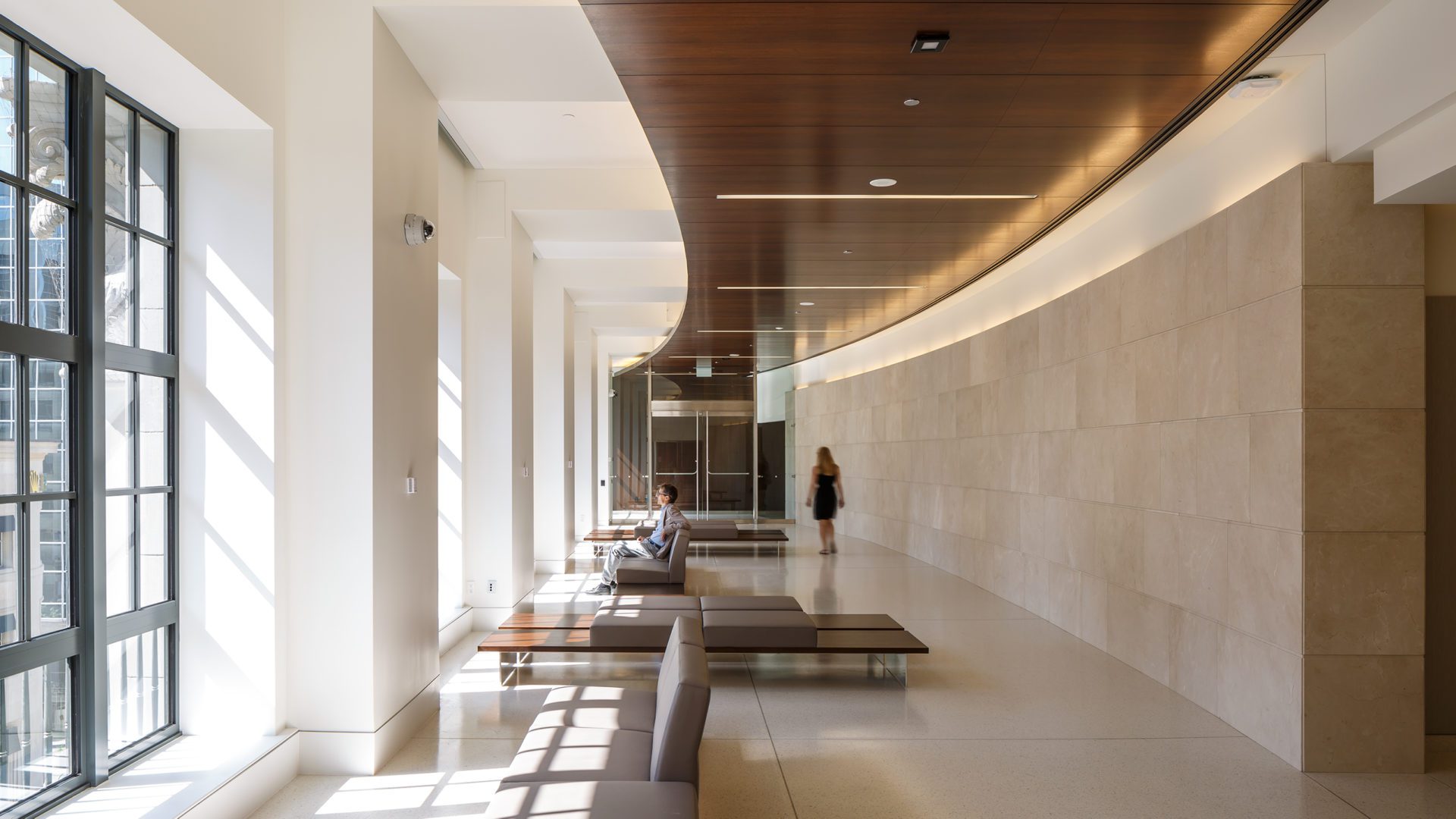The unique elements of a heritage building are what make them spectacular, but also what make them challenging to future proof. A formal process and approach must be taken to identify the constraints and opportunities before architecture and engineering work begins. The resulting facts inform the appropriate strategy, integrated program and design solution.
As part of our Blog Series titled Future Proofing Heritage Buildings, members of our multi-disciplinary team collaborated on strategic approaches to introducing a new design vision into a fixed heritage framework.
What are the first steps to consider for a heritage project?
Hassan Saffarini, CAHP, Principal
Canada’s Historic Places Standards and Guidelines provide clear rules that NORR follows when dealing with a heritage building undergoing rehabilitation. There are elements of a heritage building that simply can’t be compromised, but there are solutions that we can still identify. For example, it is acceptable to replace a roof to accommodate an expanded program, in a manner that respects the building’s heritage value, but it is not acceptable to construct an addition that requires removing a character-defining roof. By introducing new programming that enhances the original intention of the site, we can achieve a solution that will last well beyond the original lifespan of the building.
Tobias Fellows, Principal
By understanding the “Statement of Significance”, our team can develop a plan to address the character-defining elements of a heritage project. It is important to establish this conservation approach early in the process, identifying how the building needs to work from the programming side and how it can meet or exceed the client’s requirements. What exactly do these spaces need? Will the programming fit into the Heritage Building? Can we merge these two uniquely different elements, the new program with the existing building? These are questions and conversations that our integrated team covers at the start of every project.
David Clusiau, Vice President
Identifying the program elements that align with the character-defining elements helps us leverage the heritage qualities of the building. The Sir John A. Macdonald Building in Ottawa, ON is a great example of discovering a modern program that is a better fit for the abandoned bank hall. Our team restored the Beaux Art deco facade and interior into a new room of state for the Government of Canada. At the same time, we optimized energy efficiency, safety, security and new seismic measures.
William Westhafer, Vice President
We need to accept some amount of compromise and added design measures as a result of existing architectural features that must be worked around. For example, introducing open office plans into an open masonry vaulted space will require a different approach to lighting and acoustics. A beautiful curving stone stairway may have to be supplemented with an enclosed fire stair tower. Large expanses of beautiful steel framed windows introduce glare that must be tempered. A series of smaller rooms may result in the program requiring more square footage as a result of inefficiencies, and additional measures may have to be taken, such as more collaboration spaces, to compensate for staff being more separated. At the same time, these compromises can result in a design solution that is more elevating than if the same program had been configured in a more contemporary but perhaps featureless building.
Mal Lorimer, Senior Architect
Our approach to a heritage structure always starts with getting to know the building intimately. What (precisely) is it made of? What methods of craftsmanship have gone into its making? And by who and how was it used over its history? Only then can we start to understand the significance of each part and work with our clients and fellow consultants to plan. Ultimately, any building is only a success if it works for its users and is built to adapt to their changing needs.
Lizanne Dubien, Studio Manager
We take pride in educating our clients about introducing new programming to a heritage building. Designs in The Wellington Building in Ottawa, ON called for every Member of Parliament’s office to have the exact same square footage. We needed to present flexible solutions to our client to work within the confines of a building that was originally built in 1927. Our team made sure the heritage rooms were preserved and restored while introducing new programming for the House of Commons.
How do we balance the vision for a sustainable future and efficient building with the constraints of heritage guidelines?
David Clusiau, Vice President
As designers, we need to be able to achieve durability and performance objectives as well as conservation requirements so that the important character-defining components are not negatively impacted. One technique is to examine the building program, identifying the components that will put the most environmental stress on the existing heritage envelope and locate them in a separately controlled zone or an addition if possible, reserving the heritage building only for program elements that will have minimal environmental demands. At the same time, technical assessment of the heritage envelope and its seasonal performance will establish, in a solid masonry construction for example, the amount of insulation and type that can be added without adversely affecting long-term integrity. By using strategies that optimize program relocation and system selection for the circumstances you’re dealing with, you can achieve a solution that makes everyone happy.
Tobias Fellows, Principal
Everything needs to be considered when we are trying to increase a building’s efficiency right down to the smallest details. If we want the performance of a modern window for example, it must be developed and designed in a way that is sympathetic to the original heritage building. It is not simply an aesthetic decision and a matter of specifying a high-performance window. Our teams need to understand its impact on both the character-defining elements and the overall performance the building envelope. We need to look at the window in relation to the entire enclosure ensuring it does not adversely affect its performance or durability of the envelope. If done incorrectly, designers can unknowingly cause damage to the heritage facade and it will perform worse and fail over time. Having a sound understanding of these complex interactions requires research, advanced modeling and material testing to make sure the building is resilient and sustainable into the future.
Mal Lorimer, Senior Architect
Planning a building’s long-term future also necessitates a robust sustainability strategy. Fortunately, our legislative framework in the UK gives us flexibility when it comes to dealing with existing, and particularly listed buildings. We must effectively plan where upgrading thermal elements will cause the least harm to a heritage asset and bring maximum benefit in use.
How can we ensure heritage building design solutions fit into the urban fabric of our communities?
Tobias Fellows, Principal
Fitting a design vision into an urban framework needs to consider the constraints and context of the cities we work in. The urban fabric itself is an important historic element that needs to be appropriately respected. Naturally, individuals and communities have strong feelings about where they live. In Ottawa, ON our projects need to respect the protected skyline views of the city, defined by the National Capital Commission. Using visualization tools, we can help our clients by assisting them to communicate the design approach to stakeholders and the greater community, providing them with the ability to understand these impacts. This collaborative and inclusive approach provides valuable input into our design process and helps our teams identify constraints and opportunities early-on so we can propose design solutions that enhance the skyline and do not detract from their historic beauty, and the deep meaning people prescribe to them.
David Clusiau, Vice President
Public heritage buildings play an enormously important role in the urban fabric of the communities they reside in. They are often a key landmark in the city. Their disappearance, which can be instigated by no longer being needed for their original purpose, can be a significant loss. We transformed the John Sopinka Courthouse in Hamilton, ON by taking the old Dominion Building that was originally the main post office and transforming it into a courthouse. This transformation helped with the revitalization of Hamilton’s downtown core returning an institutional use to this important core location. Renewal work has a large role to play in the preservation and growth of communities and we welcome that responsibility.
Photo Credit: doublespace photography ©



